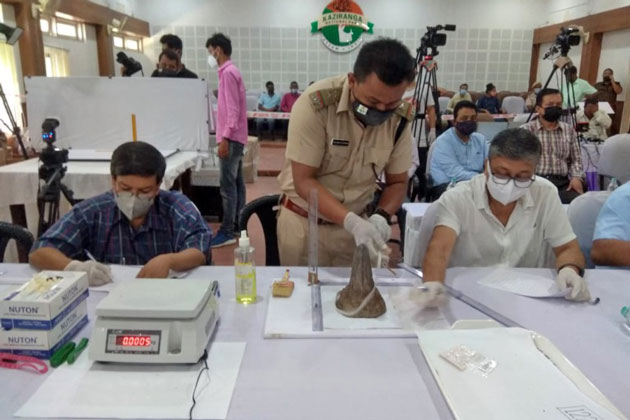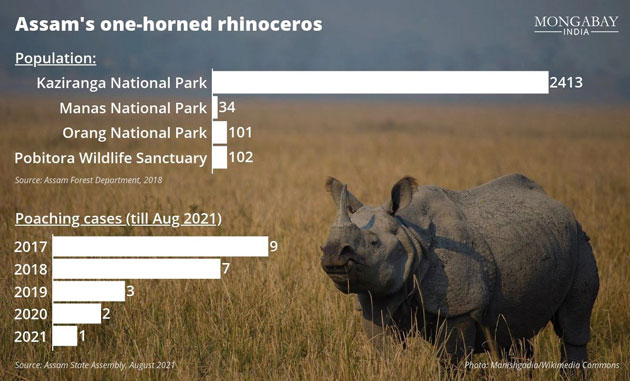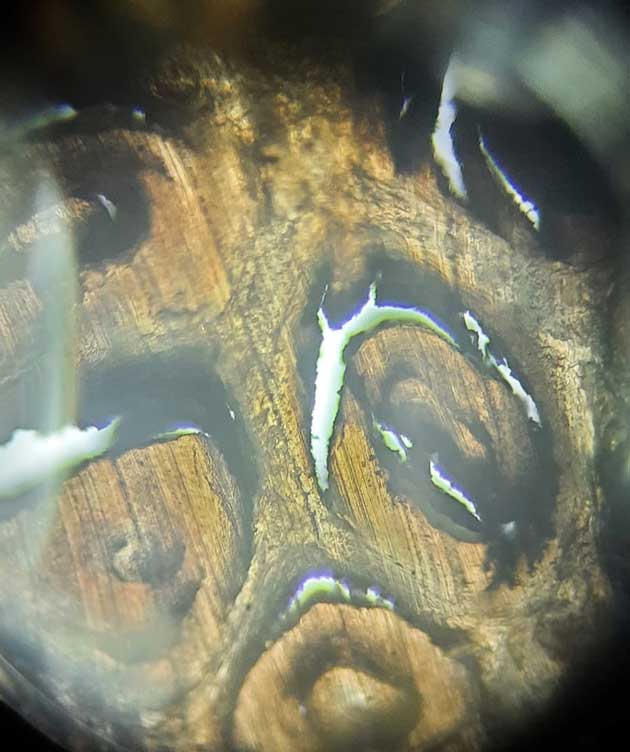Assam to destroy nearly 2500 seized rhino horns in anti-poaching message

- Assam government is considering burning the stockpile of rhino horns, along with other body parts of animals, primarily seized from illegal trade and stored in treasuries across the state.
- The probable burning of these horns was preceded by a complete reverification and counting of the horns. Around 5% of the horns which possess unique characteristics will be preserved by the government for academic use.
- An exercise of this magnitude has never been carried out in India and even Asia, and the move has been welcomed by conservationists across the country.
September 22 is a special day in the calendar of the forest department and wildlife lovers of Assam. It’s World Rhino Day, marking the occasion for celebrating the one-horned rhinoceros (Rhinoceros unicorns), the state animal of Assam. The occasion this year, however, might become even more significant because of a landmark exercise undertaken by the state’s environment and forest department that plans to burn nearly 2,500 rhino horns along with body parts of other protected species, including ivory, primarily seized from poachers and stored in treasuries across the state over decades.
The Assam state government, in its cabinet meeting on September 16, took the decision that 2,479 pieces out of 2,623 rhino horns stockpiled in state treasuries will be set aflame in public. Through this sensational move, the government hopes to send out a signal to poachers about the futility of illegal wildlife trade, busting myths about their medicinal use and in turn stopping the poaching of rhinos in the state.
In addition, as many as 94 of the stockpiled rhino horns will be preserved as heritage pieces for academic purposes while 50 rhino horns would be reserved for court cases. The exercise will be executed in accordance with the relevant section of the Wildlife (Protection) Act, 1972 and in compliance with a Gauhati High Court order in 2010 that had directed the Assam forest department to hold a public hearing on the proposed burning of the rhino horns.

“This entire exercise will send a very strong signal to poachers that the horns and other animal parts are absolutely useless for the government. Science should prevail, not superstition. Rather than protecting rhino horns, we need to protect the live rhinos and their habitat,” Hemkanta Talukdar, Chief Conservator of Forest, Central Assam Circle told Monagabay-India.
The move was welcomed by conservationists across the country. Speaking to Mongabay-India, Saket Badola, country head of TRAFFIC India, a wildlife trade monitoring network said, “Mass destruction of seized rhino horn stockpiles is an emphatic way to demonstrate the country’s commitment to end crime against endangered wildlife. This exercise will be one of the first to be carried out in the country and the region. The government of Assam deserves credit for conceptualising and carrying this out in a very methodical way. It will also send a message that the rhino horns are of use only for the rhinos and for no one else.”
Supporting the decision, Rathin Barman, Joint Director of Wildlife Trust of India, tweeted a photo of a cross-section of a rhino horn, emphasising the lack of scientific evidence for its purported medicinal value. “This is a cross-section of a #rhino horn under microscope. Just a bundle of hairs. Keratin. Does not have any medicinal value. Let us not assign any monetary value for it. If we do then we don’t believe science and support superstition (sic),” he said in the tweet.
Well-known birder and wildlife cartoonist, Deborshee Gogoi, recommends that the government could give one horn to the zoology dept of all the colleges in the state. “Rather than burning all the horns, if one horn can be given to every college, it can serve the purpose of educating the students about the components that make up a rhino horn. Obviously, the question of the security of horns will be there. A governing council body can be formed in the college which will be in charge of the security of the horn,” said Gogoi, an assistant professor in the Department of Commerce, Digboi College, Assam.
Rhino horns are composed entirely of keratin, a protein found in fingernails and hair, and are prized for their supposed medicinal properties and as good luck charms. There are 2,650 rhinos in Assam across four protected areas.

Detailed reverification before burning
The forthcoming event to destroy the stockpile is preceded by a complete reverification of these horns, a cumbersome process, which in this case was scheduled and executed across treasuries in the state. The process of verification involves transportation of a sealed box from the treasury to the reverification facility, cleaning and examination by the forensic expert after which a general Unique Identification Number (UIN) is assigned as a bar code to the examined horn and a suite of scientific examinations.
This includes an exercise to drill out biological samples of around five grams for genetic study of each of the horns, shared veterinarian, Kushal Konwar Sarma, who is a member of a newly-formed central committee constituted for reconciliation of the horns.
“Also, about one gram is collected similarly for structural and chemical composition analysis for about 2 horns every 10 years. Some of these horns are five to six decades old. By preserving the DNA samples of these horns, we will be able to know about the genetic regression, migratory pattern of these animals even after hundreds of years,” said Sarma.
Opining that horns that weigh more than 1.5 kg should be preserved, he batted for setting up a natural history museum where such iconic specimens could be preserved for posterity.
The samples obtained are sealed in airtight containers. Each horn after completion of the sample collection is again weighed, then individually packed and labelled. The labelled horn is scanned for barcode authentication. About five percent of the horns with unique characteristics are preserved for academic use. Horns for preservation and destruction are kept in separate boxes. The entire verification process is recorded on video and displayed live on monitors kept outside the room, for public viewing and the purpose of transparency.
The verification process was completed on September 12 and after the final count, 2,598 rhino horns were verified in all the treasuries across the state of Assam.
Veteran journalist Mrinal Talukdar, who participated in the verification process in Barpeta and Nagaon said, “There has been seepage in the Barpeta treasury for over twenty years which has destroyed many horns. Some of these horns date back to the 1970s and 1980s. Now, they have become very soft, almost like a sponge.” He wishes for the heaviest and longest horn to be displayed at the international airport at Guwahati.
During the process, the longest horn (51.5 cm long and weighing 2.5 kg) was found in the Guwahati treasury (it dates back to 1961) while the heaviest horn (weighing 3.05 kg and 36 cm in length) was found in Bokakhat (it dates back to 1982; found in Bagori range of Kaziranga National Park).
The question of fake horns
In 2016, a panel was constituted which counted and verified rhino horns kept in various treasuries across the state, after allegations surfaced that fake horns were kept in treasuries replacing real ones.
Right To Information (RTI) activist Dilip Nath who had made the allegation at that time told Mongabay-India, “V. K. Vishnoi, who was the Principal Chief Conservator of Forest (PCCF), Assam at that time had said that 1600 horns will be burned. However, I had information that there were 2100 horns in the treasury. So, I raised the question about the remaining 500 horns. I was then asked to participate in the counting and verification process.”
“After final counting, we had got around 2100 horns. I remember there was a box in the Golaghat treasury that couldn’t be opened as the keys were not found. We got six fake horns after counting, five from Tezpur and one from Golaghat. The fake horns were of various kinds, made of wood, bamboo and even cement,” he said.

Wildlife crime investigator, Rahul Dutta, admitting the presence of a booming fake horn market says, “There is this joke that whenever a rhino gets poached in Assam, four fake horns surface in the market that night. Places like Kaliabor and Dhing are almost like cottage industries of fake horns. However, even if the horn is fake, these people who deal in it are important for us. If we can apprehend them, we get to know many details about the illegal rhino trade from them.”
Journalist Talukdar, who had penned the book Mandalay in 2018, that traced the trail of rhino horn trade in Southeast Asia says, “These kinds of deals are done in the most discreet manner, often on platforms like Whatsapp. Finally, when the goods are exchanged in the dark, the person who gets cheated in the process tries to dupe more people and in this process, the fake horns keep changing hands.”
If the Assam government goes ahead with its plan of burning the trophies on World Rhino Day, it will be a landmark moment because something of this magnitude has not been attempted in Asia.
Conservationist and honorary wildlife warden of Guwahati, Kaushik Baruah told Mongabay-India, “In Nepal, they had burned a significant number of animal body parts and trophies at Chitwan National Park. A few years ago, an exercise of this kind was performed at Delhi Zoo as well, though on a much lower scale. What is being planned in Assam has not been attempted in Asia before. Such exercises, however, happen regularly in Africa. In 2016, Kenya had burned 105 tonnes of ivory and more than a tonne of rhino horn.”
In Africa, however, there is this raging debate about burning rhino horns versus legalising the rhino horn trade. There is a section of rhino farmers who insist on legalising rhino horn trade because they are of the opinion that the traditional market for rhino horns in countries like China and Vietnam would never go away and legalising the trade can bring funds for the conservation of rhino, an idea which is vehemently opposed by most conservationists.
Veterinarian Sarma says, “India is a signatory to the Convention on International Trade in Endangered Species (CITES) and it can’t sell body parts of protected animals. However, the smaller African countries in poor financial condition try to negotiate with CITES. They ask for some sort of compensation or else they threaten to sell the body parts of endangered animals.
This article first appeared on Mongabay.







